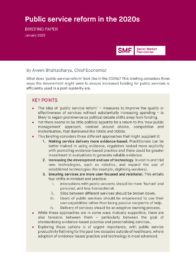What does 'public service reform' look like in the 2020s? This briefing considers three ways the Government might seek to ensure increased funding for public services is efficiently used in a post-austerity era.
KEY POINTS:
- The idea of ‘public service reform’ – measures to improve the quality or effectiveness of services without substantially increasing spending – is likely to regain prominence as political debate shifts away from funding.
- Yet there seems to be little political appetite for a return to the ‘new public management’ approach, centred around choice, competition and marketisation, that dominated in the 1990s and 2000s.
- This briefing considers three different approaches that might supplant it:
- Making service delivery more evidence-based. Practitioners can be better trained in using evidence, regulators tasked more explicitly with promoting evidence-based practice and there could be greater investment in evaluations to generate reliable evidence.
- Increasing the development and use of technology. Invest in and trial new technologies, such as robotics, and expand the use of established technologies (for example, digitising services).
- Ensuring services are more user-focused and relational. This entails four shifts in mindset and practice:
- Interactions with public servants should be more ‘human’ and personal, and less transactional
- Silos between different services should be broken down.
- Users of public services should be empowered to use their own capabilities rather than being passive recipients of help
- Delivery of services should be an adaptive learning process.
- While these approaches are in some ways mutually supportive, there are also tensions between them – particularly between the goal of standardising evidence-based practice and personalising services.
- Exploring these options is of urgent importance, with public service productivity flatlining for the past two decades outside of healthcare, where adoption of evidence-based practice and technology is most advanced.

DOWNLOAD THE BRIEFING PDF
